WP 1: Pathways through swelling and shrinkage processes
News (December 2022)
Hydro-mechanical effects and cracking in Opalinus Clay
Towards concluding the project, we summarized our workflow and findings concerning the Opalinus Clay (OPA) in a dedicated chapter of the GeomInt2 open access book. We investigated hydro-mechanical effects both at laboratory and field scales. Laboratory experiments from CAU led to a mechanical and hydraulic characterization of the OPA, e.g. how the fracture toughness is affected by different bedding angles and suction. In the field, BGR continued investigating the Cyclic Deformation (CD-A) experiment with respect to the water content changes. Concerning the numerical approaches used to simulate both laboratory and field scale setups, an unsaturated hydro-mechanical (HM) approach was combined with (i) the Finite Discrete Element Method (FDEM) by CAU and (ii) the Phase-field modeling approach by BGR and UFZ. The two extended HM approaches were applied to reproduce cracks at different applications, e.g. pure shear tests, excavation of the CD-A twin niches (Fig. 1) and desiccation in two- and three-dimensional settings (Fig. 2). The applications allowed us to identify potential workflows for using and transferring the approaches from laboratory to the field scale. For further details, we refer the interested readers to our chapter in the GeomInt2 book.
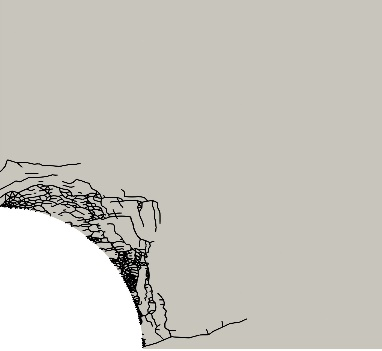 Fig. 1: Modeled cracks due to excavation in the CD-A experiment. The cracks were modeled with the Finite Discrete Element Method (FDEM) with a quarter 2D model of the CD-A niche [CAU].
Fig. 1: Modeled cracks due to excavation in the CD-A experiment. The cracks were modeled with the Finite Discrete Element Method (FDEM) with a quarter 2D model of the CD-A niche [CAU].
 Fig. 2: Modeled desiccation cracks due to desaturation in the CD-A experiment. The cracks were modeled with the phase-field approach with a quarter 3D model of the CD-A niche. The elements with damage above 99% are deleted, while the color plots represent the saturation degree [BGR, UFZ].
Fig. 2: Modeled desiccation cracks due to desaturation in the CD-A experiment. The cracks were modeled with the phase-field approach with a quarter 3D model of the CD-A niche. The elements with damage above 99% are deleted, while the color plots represent the saturation degree [BGR, UFZ].
[CAU] In order to have a better understanding regarding the involved heterogeneities in the process of shrinkage induced cracking around open nitches and galleries, the evolution of Excavation Damage Zone (EDZ) in Opalinus clay was considered in the FDEM numerical modelling. The numerical model shown in Fig. 3.a. represents the formation of EDZ in a numerical test case based on CDA-experiment where effects of anisotropy (isotropy planes aligned in horizontal direction) are included. As the distance from tunnel faces increases, the percentage of damaged regions around the opening decrease following a power-law distribution. As shown in Fig.3.b, such failure pattern could be abstracted in modification of the hydro-mechanical parameters, e.g. permeability, and further used in following numerical modelling of shrinkage induced cracking.
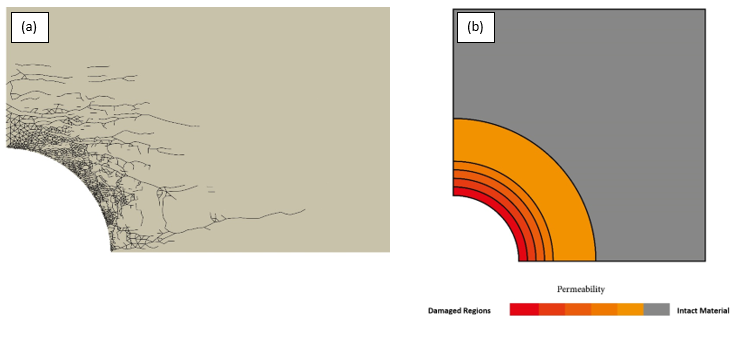 (a) Final EDZ pattern around tunnel face (b) EDZ damage abstraction
(a) Final EDZ pattern around tunnel face (b) EDZ damage abstraction
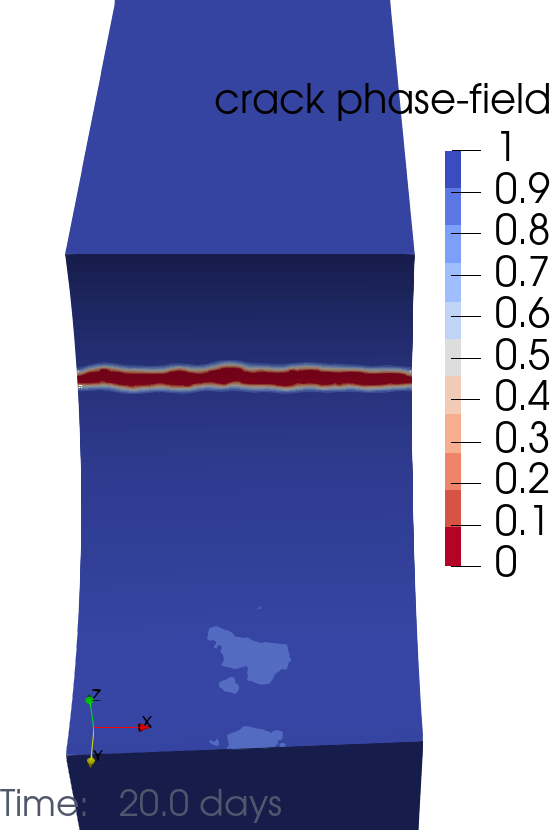 Simulation results of crack development at the wall of the CD-A experiment. The crack develops between 93-94 % RH (suction 8-9 MPa) within the range of experimental results.
[BGR#UFZ] Desiccation cracking in unsaturated porous media: To model shrinkage-induced (desiccation) cracking at the field scale of the CD-A experiment, an extensive calibration procedure using experimental data has been carried out. The calibration intended to estimate the fracture energy and the crack resolution for the numerical model. For that, the elastic modulus, fracture toughness and tensile strength of the Opalinus Clay were used. The numerical predictions of a reference test case using the parallelized Richards Mechanics PhaseField process in OGS 6 follow the experimental in-situ observations and tendencies. As an example, crack develops between 93-94 % RH (suction 8-9 MPa). Although the crack front stops due to a local mesh refinement, the number of obtained cracks in the numerical model is in accordance with the average number of cracks in the experiment, i.e. 3-4 cracks/meter. The results and methodology have been presented and discussed in international conferences such as Interpore and Clay Conference. Currently, the results of the calibration procedure are being summarized in a scientific paper.
Simulation results of crack development at the wall of the CD-A experiment. The crack develops between 93-94 % RH (suction 8-9 MPa) within the range of experimental results.
[BGR#UFZ] Desiccation cracking in unsaturated porous media: To model shrinkage-induced (desiccation) cracking at the field scale of the CD-A experiment, an extensive calibration procedure using experimental data has been carried out. The calibration intended to estimate the fracture energy and the crack resolution for the numerical model. For that, the elastic modulus, fracture toughness and tensile strength of the Opalinus Clay were used. The numerical predictions of a reference test case using the parallelized Richards Mechanics PhaseField process in OGS 6 follow the experimental in-situ observations and tendencies. As an example, crack develops between 93-94 % RH (suction 8-9 MPa). Although the crack front stops due to a local mesh refinement, the number of obtained cracks in the numerical model is in accordance with the average number of cracks in the experiment, i.e. 3-4 cracks/meter. The results and methodology have been presented and discussed in international conferences such as Interpore and Clay Conference. Currently, the results of the calibration procedure are being summarized in a scientific paper.
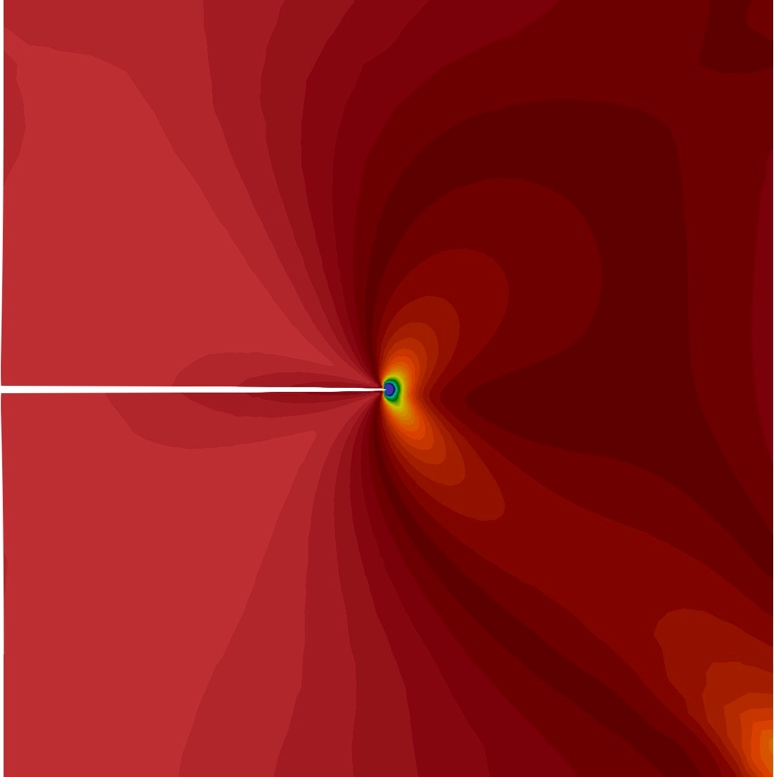 The magnitude of the strain tensor at the initiation of the crack for orthotropic material
Crack propagation in anisotropic media: Geomaterials are known to exhibit anisotropic behavior. Anisotropic material response manifests itself in terms of either deformation or preferential fracture propagation. With regard to the former one, we propose a decomposition of the constitutive relations into a crack-driving and a persistent portion, specifically designed for materials with initial anisotropic/orthotropic behavior. The decomposition is implemented in the phase field approach to fracture. Two benchmark problems, a tensile test and a shear test, are used to study the performance of the present model. The results can detain the anisotropic constitutive behavior and the tension-compression asymmetry in the crack response, and are in accordance with the expected behavior for orthotropic materials. In addition, the results are verified numerically by means of a Gθ energy release rate computation. This work was presented in ECCOMAS2022, and received feedback from a few expertise in the field. Also, we prepared a manuscript to be submitted to a top-rated journal shortly. We also started to extend our model development works into plasticity, and currently we are implementing it into OGS 6.
The magnitude of the strain tensor at the initiation of the crack for orthotropic material
Crack propagation in anisotropic media: Geomaterials are known to exhibit anisotropic behavior. Anisotropic material response manifests itself in terms of either deformation or preferential fracture propagation. With regard to the former one, we propose a decomposition of the constitutive relations into a crack-driving and a persistent portion, specifically designed for materials with initial anisotropic/orthotropic behavior. The decomposition is implemented in the phase field approach to fracture. Two benchmark problems, a tensile test and a shear test, are used to study the performance of the present model. The results can detain the anisotropic constitutive behavior and the tension-compression asymmetry in the crack response, and are in accordance with the expected behavior for orthotropic materials. In addition, the results are verified numerically by means of a Gθ energy release rate computation. This work was presented in ECCOMAS2022, and received feedback from a few expertise in the field. Also, we prepared a manuscript to be submitted to a top-rated journal shortly. We also started to extend our model development works into plasticity, and currently we are implementing it into OGS 6.
[BGR#UFZ] Dessication crack modeling: To handle the large number of degrees of freedom present in, e.g. field scale models, Richards Mechanics PhaseField process in OGS 6 has been parallelized. The feature includes mixed form elements such as Taylor-Hood, which are essential when modeling shrinkage-induced cracking. Several tests were carried out with two- and three-dimensional setups. A preliminary model representing the geometry of a geological window of the open niche from the CD-A experiment was simulated. The first calculations were used as proof-of-concept and were able to reproduce shrinkage-induced cracks as shown in the figure below. Our current task is to understand the influence of the mesh, crack resolution and numerical parameters such as the irreversibility condition on the crack evolution. In addition, the calibration of strength properties is underway. The UFZ, BGR and CAU Kiel institutions are discussing the possibility to compare the responses of their numerical codes when using the same setup. The idea is to use the geomechanical properties and experimental results obtained in CAU’s laboratory and to numerically verify how cracks propagate under mechanical loading. The setup offers the opportunity to test the code recently implemented by UFZ, which accounts for an orthotropic phase-field approach during mechanical loading. In this context, the simulations to be performed by BGR and UFZ will assist the discussion and extension of the coupled hydro-mechanical model code to also account for orthotropy.
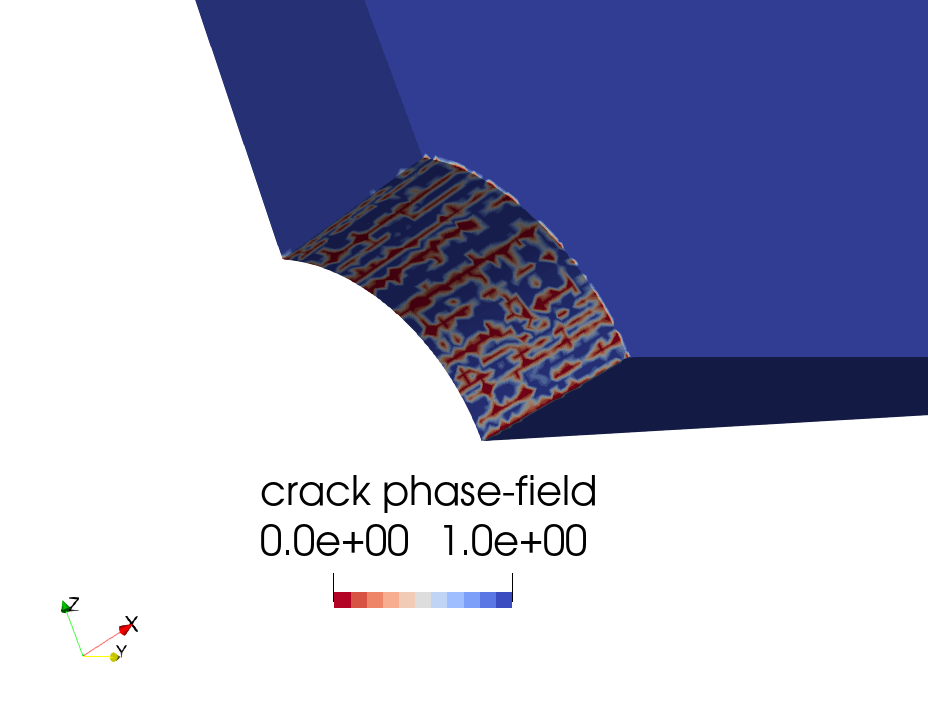 Preliminary results obtained with 3D mesh showing the crack phase-field evolution due to drying. The quarter model represents the geometry of a geological window from the CD-A experiment.
Preliminary results obtained with 3D mesh showing the crack phase-field evolution due to drying. The quarter model represents the geometry of a geological window from the CD-A experiment.
Crack propagation in orthotropic material: We propose a new direction-dependent model for the unilateral contact constraint involved in the phase field approach to fracture for brittle materials with an anisotropic/orthotropic nature. The model satisfies the orthogonality condition for anisotropic materials. Consequently, the additive decomposition of the strain tensor into a positive (tensile) part and a negative (compressive) part is in such a way that the strain energy density is correspondingly partitioned into a crack-driving and a persistent part which, respectively, only depend on positive and negative strain tensors. This implies that the present model can be applied to arbitrary anisotropic elastic behavior. On this basis, we generalize the well-known volumetric deviatoric and masonry-like fracture models for materials with anisotropy/orthotropy. The results are expected to provide a step forward when developing phase field fracture theories for brittle materials with anisotropic nature.
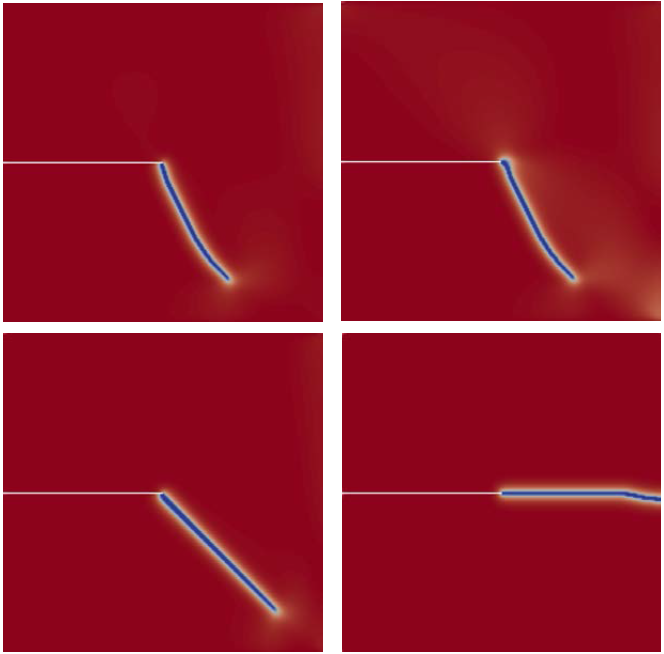 A representative result for a shear test with an anisotropic material (E1/E2=3). Masonry-like (left) and volumetric-deviatoric (right) fracture models are considered, while two material orientations, horizontal (top) and vertical (bottom) are tested. The results reflect the effect of anisotropy and directional-dependency of the fracture models.
A representative result for a shear test with an anisotropic material (E1/E2=3). Masonry-like (left) and volumetric-deviatoric (right) fracture models are considered, while two material orientations, horizontal (top) and vertical (bottom) are tested. The results reflect the effect of anisotropy and directional-dependency of the fracture models.
[BGR#UFZ] One important mechanism driving shrinkage-induced cracking concerns the changes (gradients) of moisture content in the porous medium. In the past quarter, BGR has evaluated the moisture content changes in Opalinus Clay, which were monitored in-situ within the CD-A experiment. An initial geological characterization by Swisstopo has located regions with stronger water content reduction. We could link them to fractured regions and plan to further investigate the obtained data using numerical models. Moreover, we have identified and modeled the drying process in laboratory and field scales. These processes are related to drying and consequently shrinkage, and provide a basis for the application of the phase-field approach on a larger scale. With a focus on the system understanding and the context of radioactive waste disposal, we have presented and discussed the results within the interdisciplinary conference safeND. To simulate desiccation cracking in a larger field scale, the current phase-field based implementation in OpenGeoSys (OGS-6) is being extended for parallelization by UFZ.
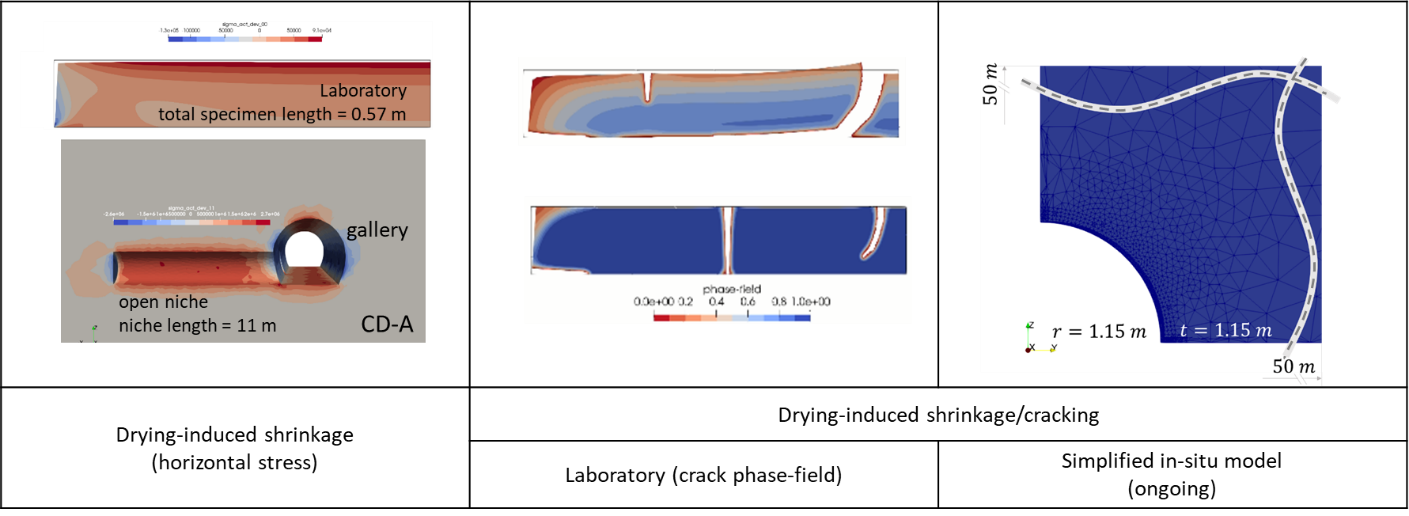 Drying-induced shrinkage has been modeled in laboratory and field scales. The results are compared and serve as basis for the application of the extended hydro-mechanical phase-field framework. The current implementation is being extended to allow simulations in a larger field scale.
Drying-induced shrinkage has been modeled in laboratory and field scales. The results are compared and serve as basis for the application of the extended hydro-mechanical phase-field framework. The current implementation is being extended to allow simulations in a larger field scale.
Additionally, to incorporate the anisotropic behavior of clay rock, a phase-field fracture model with an anisotropic constitutive relationship has been formulated and implemented in OpenGeoSys. The figure below shows examples of single edge notch test with pure shear crack propagation with varying material anisotropy (0, 45, and 90 deg).
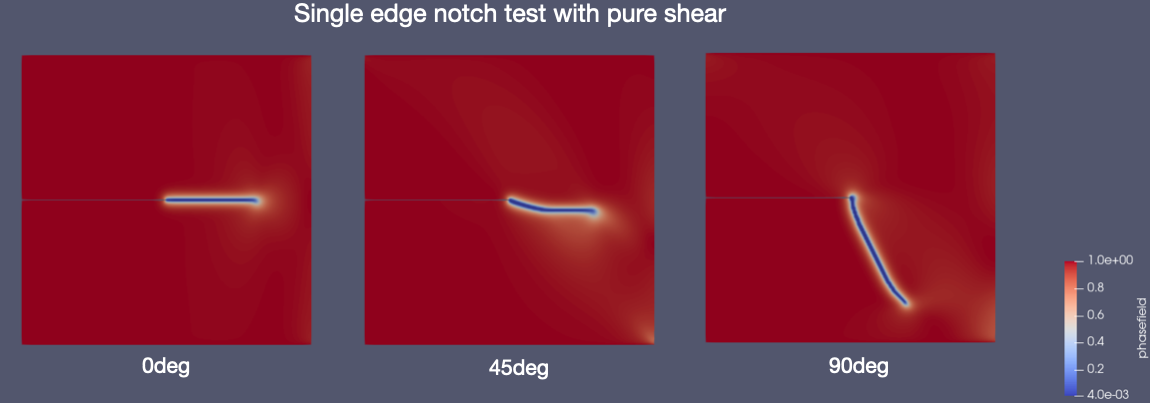
[BGR#UFZ] The various sensors placed in the twin niches of the CD-A experiment were complemented by a suction measurement system. The equipment has been purchased by the Mont Terri consortium. The system enables a more accurate measurement of the relative air humidity in lower ranges such as those corresponding to a suction regime. The monitored results will aid in understanding the differences between the boundary conditions of the niches and the possible development of shrinkage-induced cracking and thus support the development of the numerical model approach.
Horizontal and vertical borehole samples were extracted by the BGR from the open and closed niches and have been handed over to CAU for geomechanical material testing. One of the possible outcomes of the laboratory-scale experiments is to provide material parameters for the calibration of the Richards Mechanics Phase-Field model developed by BGR and UFZ. Due to the necessity of fine meshes for resolving the crack, the parallelization of the numerical framework is under consideration. Furthermore, a simplified field-scale model has been prepared and is currently being tested with the coupled framework.
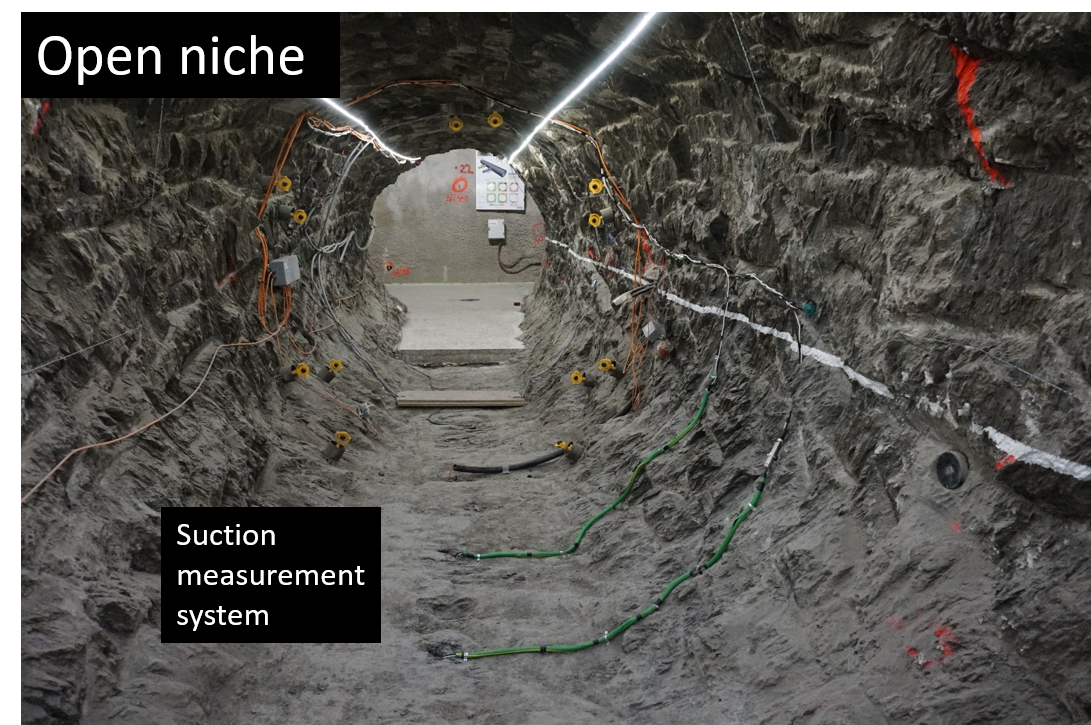 Mont Terri rock laboratory, installation of suction measurement system in the open CD-A-niche. The system enables a more accurate measurement of the relative air humidity in lower ranges such as those corresponding to a suction regime.
Mont Terri rock laboratory, installation of suction measurement system in the open CD-A-niche. The system enables a more accurate measurement of the relative air humidity in lower ranges such as those corresponding to a suction regime.
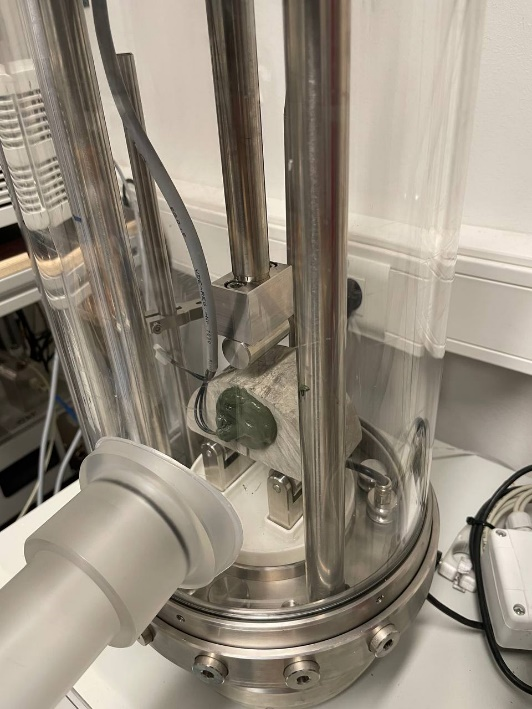 Customized Desiccator Cell and Final Set Up
[CAU#BGR] The borehole cores of A24&26 (vertical) and A25&27 (horizontal) nitches have been collected from BGR. The semi-circular samples for Mode-I fracture toughness test is under preparation at CAU. For preservation of initial state, the sample preparation takes place according to the experimental work flow. The new and customized desiccator cell, with a built-on three-point bending test frame, has arrived at CAU of Kiel and set up (Fig.1). The test procedure includes two stages. First, the sample is placed in the isolated cell containing the salt solution in order to reach the equilibrium state. Afterward, the three-point bending test is performed with fixed deflection rate. The obtained results, in terms of failure load and Mode-I fracture toughness (KIC) at different suction values, could be further used as input for numerical simulations.
Customized Desiccator Cell and Final Set Up
[CAU#BGR] The borehole cores of A24&26 (vertical) and A25&27 (horizontal) nitches have been collected from BGR. The semi-circular samples for Mode-I fracture toughness test is under preparation at CAU. For preservation of initial state, the sample preparation takes place according to the experimental work flow. The new and customized desiccator cell, with a built-on three-point bending test frame, has arrived at CAU of Kiel and set up (Fig.1). The test procedure includes two stages. First, the sample is placed in the isolated cell containing the salt solution in order to reach the equilibrium state. Afterward, the three-point bending test is performed with fixed deflection rate. The obtained results, in terms of failure load and Mode-I fracture toughness (KIC) at different suction values, could be further used as input for numerical simulations.
Furthermore, a coupled moisture diffusion model has been implemented in the FDEM framework. The developed model has been validated against the benchmark solutions in the literature. The model is capable of simulating shrinkage-induced fractures and moisture diffusion in presence of Discrete Fracture Network
[BGR#UFZ] The Richards Mechanics process type in OGS-6 was extended to account for cracking with the phase-field model through a joint work between BGR and UFZ. The new process type (Richards Mechanics Phase-Field) with pressure, displacement and crack phase-field as independent variables is currently undergoing testing. At this phase, BGR and UFZ check the framework and perform numerical simulations at the laboratory scale, e.g. shrinkage-induced cracking during drying of a slab. Similar cracks are observed and monitored at the in-situ scale, in the Mont Terri Cyclic Deformation (CD-A) experiment. To enable a comparison between the twin niches, which are subjected to different environmental conditions, in long-term, Swisstopo added/draw a scanline in the closed niche (the monitoring had started at an earlier stage in the open niche). Further experimental work and its evaluation are underway at BGR. The new post-processed data are related to the electrical resistivity and permeability. These samples will be handed over to CAU for geomechanical material testing.
 Symmetric clay slab subjected to drying at the upper and left surfaces. The cracks are shown in blue.
Symmetric clay slab subjected to drying at the upper and left surfaces. The cracks are shown in blue.
[BGR] We started the second phase of the project with the preparation of a CD-A simulation model in two dimensions. This model aims at a detailed study of the coupled phenomenon of deformation and pressure under variable saturation. The implementation was carried out in OGS 6 using the Richards Mechanics process type and considering anisotropy both in the mechanics and in the hydraulics. The hydraulic boundary conditions at the niches have been determined based on the experimentally monitored relative air humidity. In a zoomed view of the results corresponding to 1.5 year after the start of the CD-A experiment in Mont Terri, we can identify desaturation zones which can lead to shrinkage as well as shrinkage-induced cracking. This month such cracks were identified on site (figure below). Swisstopo draw a scanline that aids in determining the temporal evolution of the cracks (opening/closing) due to seasonal changes (desaturation/saturation). Furthermore, BGR drilled vertical and horizontal boreholes, BCD-A26 and BCD-A27 respectively, to determine the permeability and electrical resistivity, and extracted rock samples to measure the water content and further laboratory investigations in the framework of the GeomInt project.
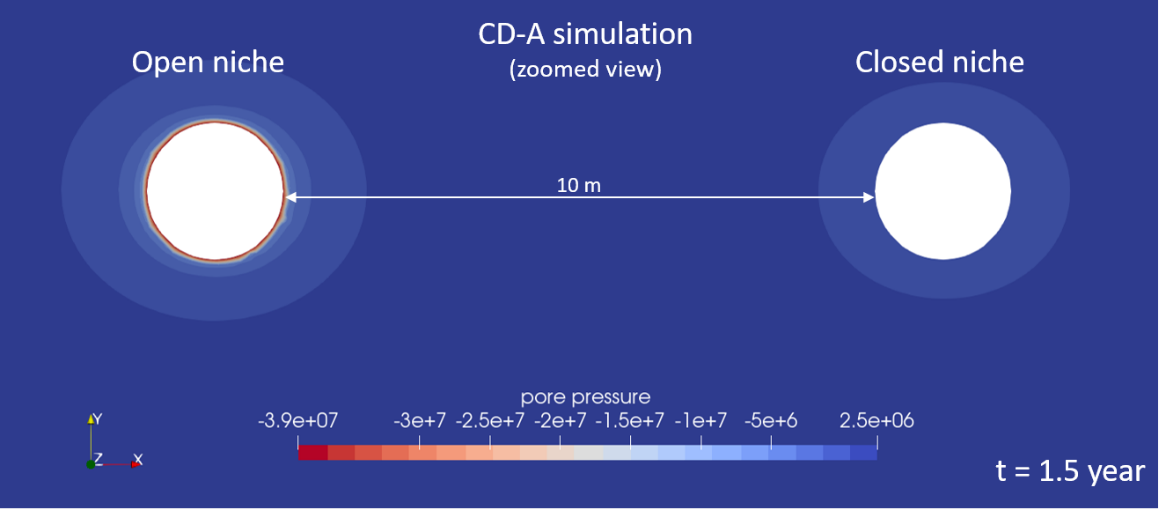
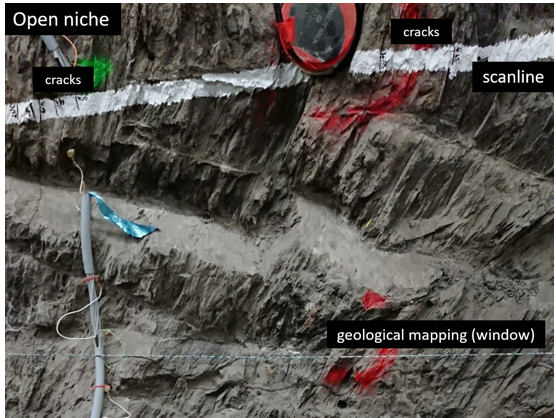
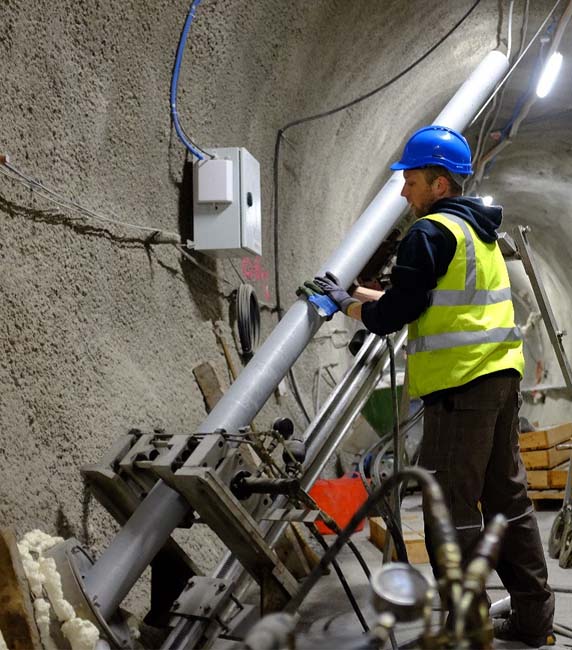 A second borehole BAD-2 with a depth of 29.2 m was drilled in May 2019 at Mont Terri. Sampling was performed by scientists from BGR and CAU Kiel. While the first borehole BAD-1 was drilled parallel to the geological layers to obtain samples from the sandy facies only, the BAD-2 was drilled perpendicular to the layering to investigate the spatial extent of the different facies. At CAU Kiel, shrinking and swelling experiments were run on claystone under applied free boundary suction and temperature conditions. When the water content of clay changes, the clay often reacts with shrinking or swelling. This can be both a problem for the sealing of underground repositories as well as a tool. The IfG conducted experiments and simulations to analyze the process and the related changes of the stress state.
A second borehole BAD-2 with a depth of 29.2 m was drilled in May 2019 at Mont Terri. Sampling was performed by scientists from BGR and CAU Kiel. While the first borehole BAD-1 was drilled parallel to the geological layers to obtain samples from the sandy facies only, the BAD-2 was drilled perpendicular to the layering to investigate the spatial extent of the different facies. At CAU Kiel, shrinking and swelling experiments were run on claystone under applied free boundary suction and temperature conditions. When the water content of clay changes, the clay often reacts with shrinking or swelling. This can be both a problem for the sealing of underground repositories as well as a tool. The IfG conducted experiments and simulations to analyze the process and the related changes of the stress state.
In geotechnical/geomechanical laboratory of CAU Kiel, the prepared two cylindrical thin sections of sandy Opalinus claystone are used to determine the drying and wetting paths. The saturated salt solutions are used to apply different osmotic suctions, such as Magnesium Chloride (MgCl2), Magnesium Nitrate (MgN2O6), Sodium Chloride (NaCl), Potassium Chloride (KCl) and Potassium Nitrate (KNO3). The suction values range from 3.2 up to 367 MPa, which insures both drying and wetting paths. The room temperature is around 20 °C and the fluctuation of the temperature is negligible. The first sample is used to determine the linear axial strains along the embedded layers, which are arranged in a parallel and perpendicular orientations. The second sample is used to determine the water content change during the wetting and drying paths. The samples dimension is 100x10 mm (DxH). The equilibrium inside the desiccator is reached when the change of the samples water content is zero. Fig. 1a. depicts the change of suction and axial linear strains in parallel and perpendicular directions. Similarly, Fig. 1b. shows the change of water content with applied suction using salt solutions. In drying path, the results indicate a higher strain for a strain perpendicular to the embedded layers. When the suction is higher than 150 MPa, the strains in perpendicular direction are almost 4.5 larger than parallel ones. Interestingly, in the wetting path, the differences between the strain gauges are much less. According to the water content data, the air-entry pressure for a sandy Opalinus claystone is found to be around 25 MPa.
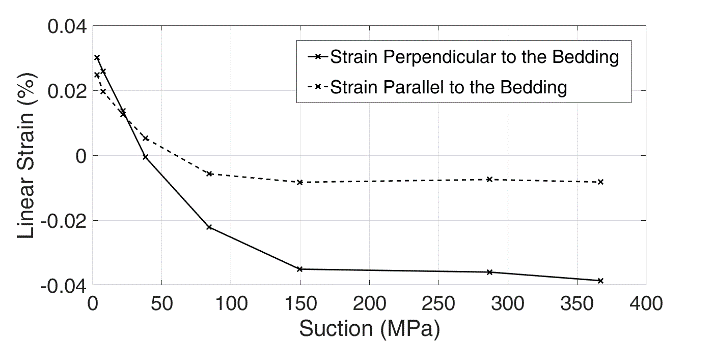
(a)
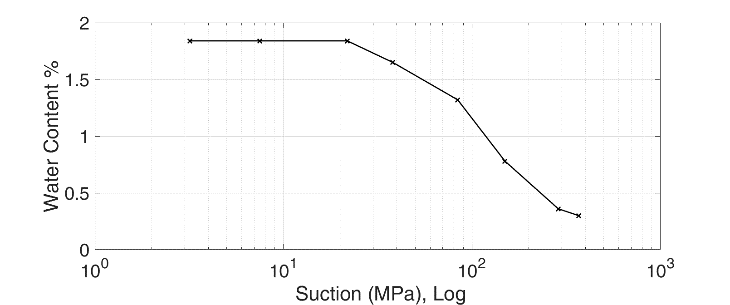
(b)
Fig. 1. The change of (a) suction and axial linear strains in parallel and perpendicular directions, and (b) water content with applied suction using salt solutions
BGR
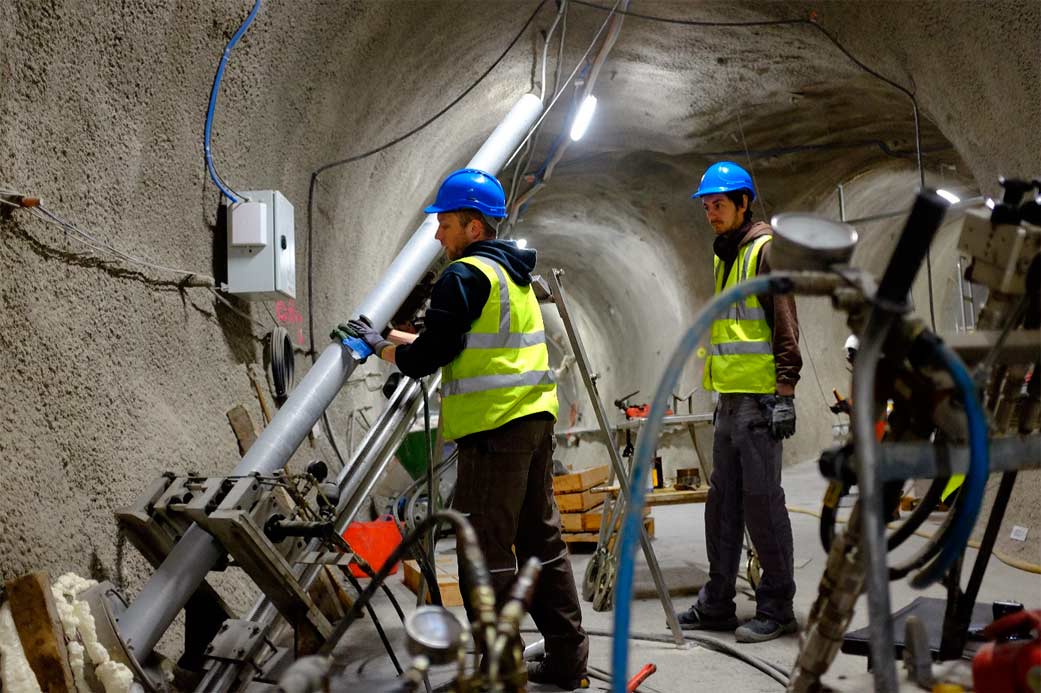 Figure 1: Drilling of the borehole BAD-2 for the AD experiment. Photo: swisstopo
Figure 1: Drilling of the borehole BAD-2 for the AD experiment. Photo: swisstopo
The experimental campaign “Experimental-Numerical Analysis of Discontinuities (AD)” in the Mont Terri Rock Laboratory was continued by the BGR in collaboration with the CAU Kiel. In particular, a second borehole BAD-2 with a depth of 29.2 m was drilled in May 2019. Sampling was performed by scientists from BGR and CAU Kiel. While the first borehole BAD-1 was drilled parallel to the geological layers to obtain samples from the sandy facies only, the BAD-2 was drilled perpendicular to layering to investigate the spatial extent of the different facies. The boreholes have been analyzed by means of Electrical Resistivity Tomography (ERT) and miniseismic techniques (Kneuker et al., 2017). The BAD-2 borehole yielded an additional 13 m of samples from the sandy facies, which will be further analyzed in the laboratory of CAU Kiel to investigate discontinuities such as the propagation of desiccation cracks.
Furthermore, the documentation of numerical simulation campaign to investigate swelling and shrinkage in an idealized niche of the Mont Terri URL was finished. This work will become a chapter in the upcoming GeomInt Book (WP4).
References:
Kneuker, T., Hammer, J., Shao, H., Schuster, K., Furche, M., & Zulauf, G. (2017). Microstructure and composition of brittle faults in claystones of the Mont Terri rock laboratory (Switzerland): New data from petrographic studies, geophysical borehole logging and permeability tests. Engineering geology, 231, 139-156.
CAU Kiel
At the geomechanical laboratory at CAU Kiel, shrinkage and swelling behavior of claystone under applied free boundary suction and temperature conditions are investigated. Shrinkage and swelling are induced by preparing two thin section samples and storing them in a desiccator, in which a salt solution with a specified osmotic suction value is placed. The salt solutions under consideration include the following: magnesium chloride (MgCl2), magnesium nitrate (MgN2O6), sodium chloride (NaCl), potassium chloride (KCl) and potassium nitrate (KNO3).
The change in water content in the second sample during a two-week period for each salt solution (long enough to reach equilibrium) is noted and a suction-water content behavior is obtained. At the same time, two linear strain gauges with a dimension of 10 mm are glued onto the first sample such that the axial strains parallel and perpendicular to layering alignment can be measured. Finally, a water content-axial strain as well as suction-axial strain behavior of claystone during the shrinkage and swelling process are captured and are implemented in the developed THM lattice model.
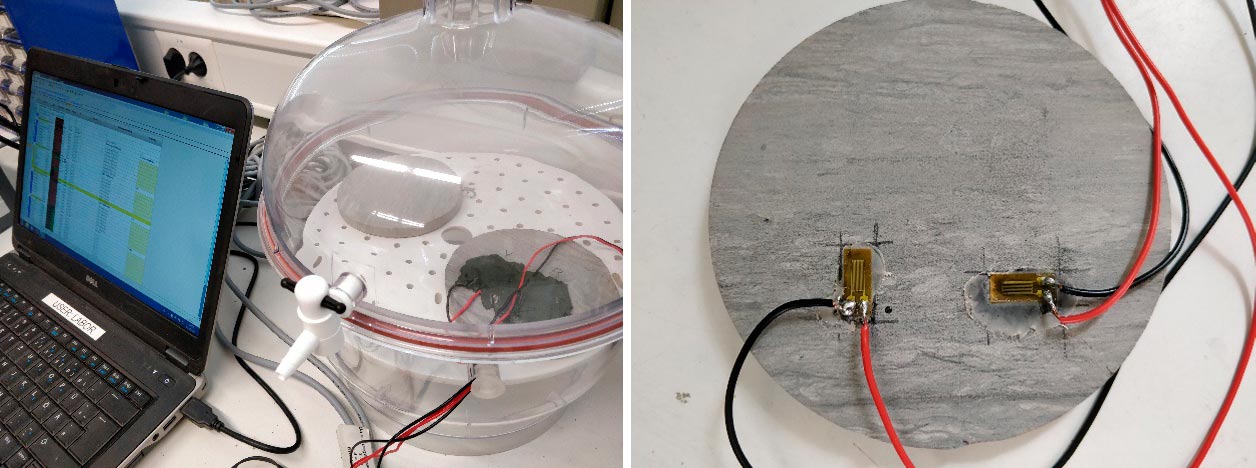 Figure 2: the prepared samples inside the desiccator for measuring the water content and axial strains (left); attachment of strain gauges on the first sample parallel and perpendicular to layering alignment (right)
Figure 2: the prepared samples inside the desiccator for measuring the water content and axial strains (left); attachment of strain gauges on the first sample parallel and perpendicular to layering alignment (right)
IfG
Experiment: Closure of pathways in clay through swelling
A dry sample of red salt clay from the Zechstein T4 series was exposed to water (2 bar) at its top and bottom surfaces. A mantle pressure of 4 bar was applied, and the permeability and volume change of the sample were monitored. Photo of setup:
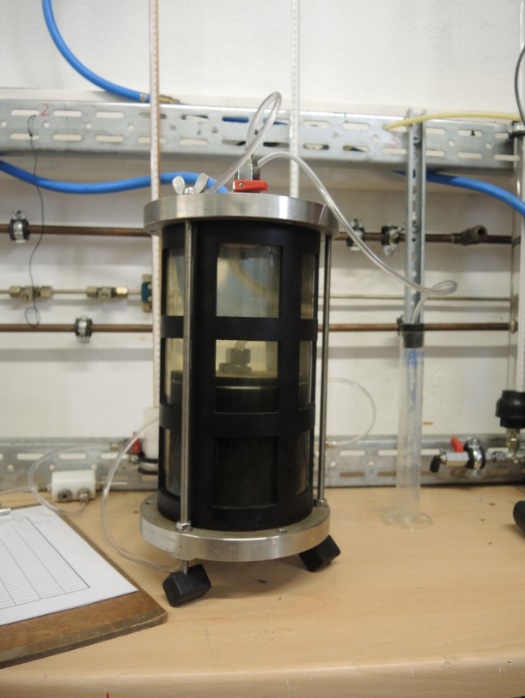 Fig. 3: Measuring device for the swelling of clay and its permeability
Fig. 3: Measuring device for the swelling of clay and its permeability
A swelling of the sample was observed through the amount of liquid inside the apparatus, which decreased over the course of weeks:
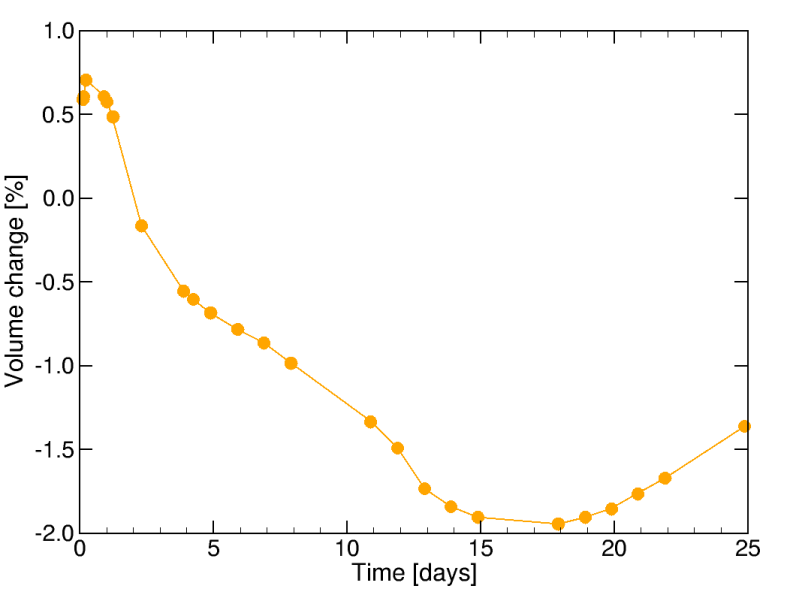 Fig. 4: Volume change of the liquid surrounding the sample
Fig. 4: Volume change of the liquid surrounding the sample
During the first week of the experiment, the permeability of the sample decreased because the swelling closed or narrowed pathways in the sample. After that, an increase in the permeability is observed as the water dissolves part of the salt in the clay, opening up new pathways.
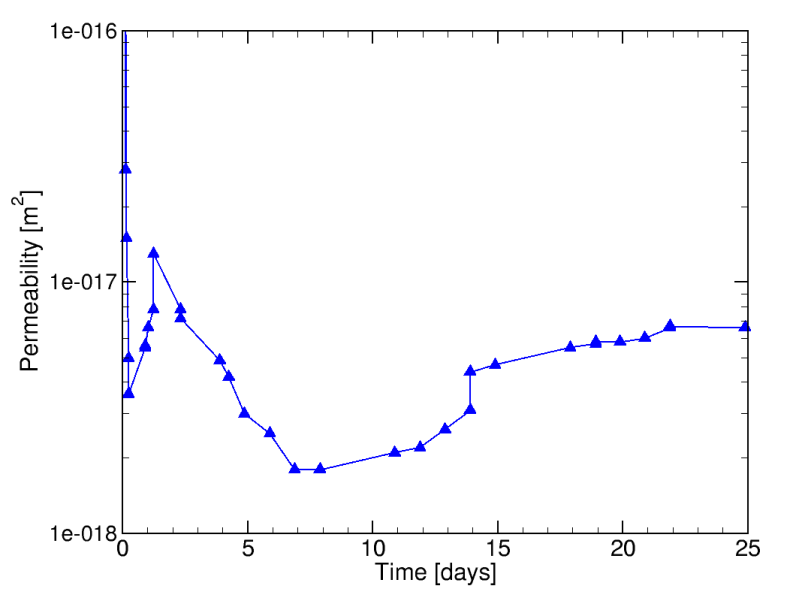 Fig. 5: Changes of permeability due to swelling and dissolution of salt
Fig. 5: Changes of permeability due to swelling and dissolution of salt
A second experiment using brine instead of water is currently running.
BGR / UFZ
Numerical investigations at BGR and UFZ have been focused on the implementation of algorithms that account for discontinuities in the Hydraulic-Mechanical (HM) modeling framework of OpenGeoSys (OGS6). To this end, extensive tests have been carried out with OGS6 at BGR to compare the simulation results generated by its predecessor OGS5 that were meant to reproduce in-situ experiments of seasonally induced cyclic deformation of a gallery in the Mont Terri Rock Laboratory (Fig. 1).
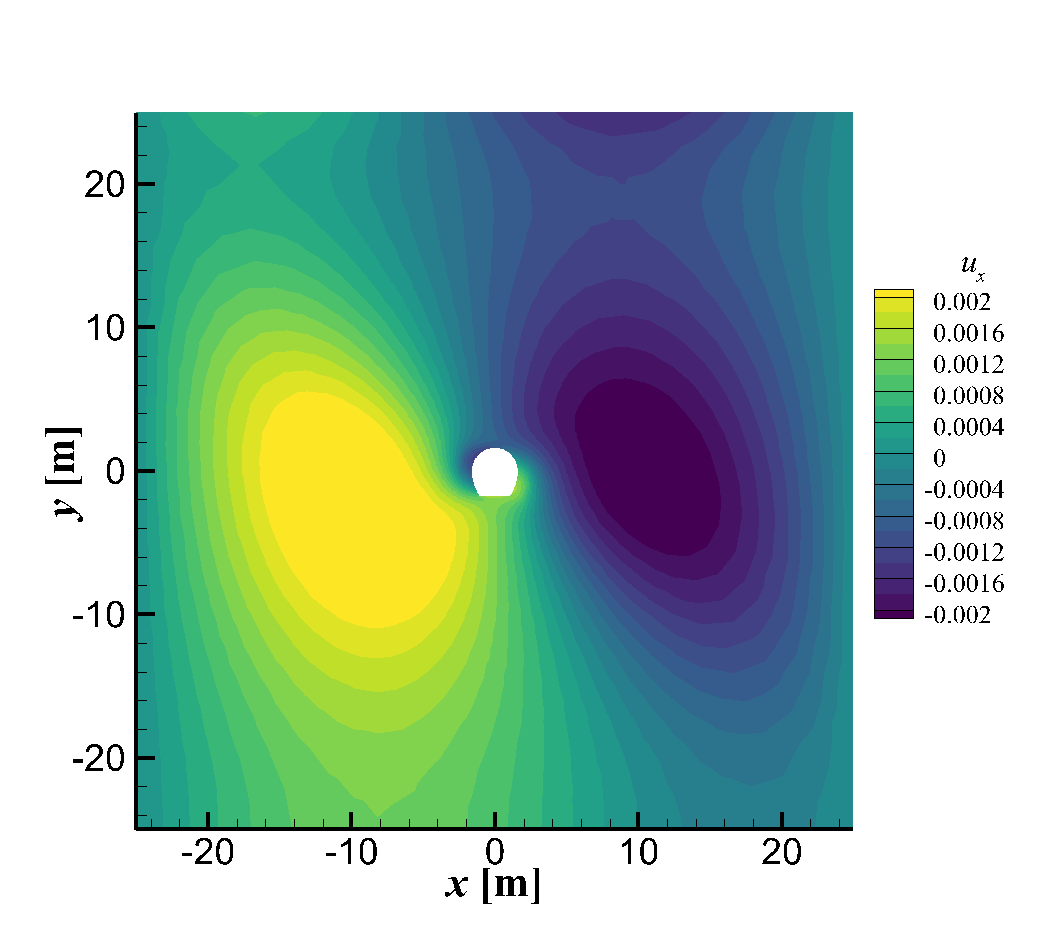 Fig. 1: Calculated vertical displacement around an excavation (induced by desiccation)
Fig. 1: Calculated vertical displacement around an excavation (induced by desiccation)
In the meantime, the UFZ has implemented the Phasefield Method in OGS6 to account for discontinuities as a damage variable, which will enhance the mechanical coupling of the HM modeling by accounting for crack propagation in the rock. As a next step, these efforts will be combined to model the cyclic desiccation and saturation of clay rocks to understand the effects of discontinuities on the mechanical properties of a gallery in the Mont Terri Rock Laboratory.
CAU Kiel
In CAU Kiel and with the application of experimental and numerical approaches, the material behavior during the shrinkage and swelling phases will be investigated. Within a free shrinkage and swelling boundaries and taking the microscopic images from the surface of the claystone, the movement of predefined mesh points on the sample surface with time will be observed. The micro-fracking and opening of the fracks will be interpreted and a shrinkage coefficient will be then deployed in the shrinkage lattice model. The 2D and 3D CAU Lattice code are able to predict the stochastic frack initiation and propagation under THM processes. The shrinkage coefficient will be then implemented in LEM to simulate the aggregate-shrinkage model.
 Fig. 2 The 3D LEM simulation of a splitting test with depicted frack surfaces with red.
Fig. 2 The 3D LEM simulation of a splitting test with depicted frack surfaces with red.
According to aggregate-shrinkage model [1], the new length of an element (L_(t+1)) in each time step is:
Where α_s is a shrinkage or swelling coefficient and T is the total time where the evaporation rate is equal to zero. The shrinkage rate depends on the amount of saturation (S) and the water pressure (p) in the interparticle porous medium. The dual Lattice model [2] is utilized to determine the water flow and developed water pressures in a porous medium [3].
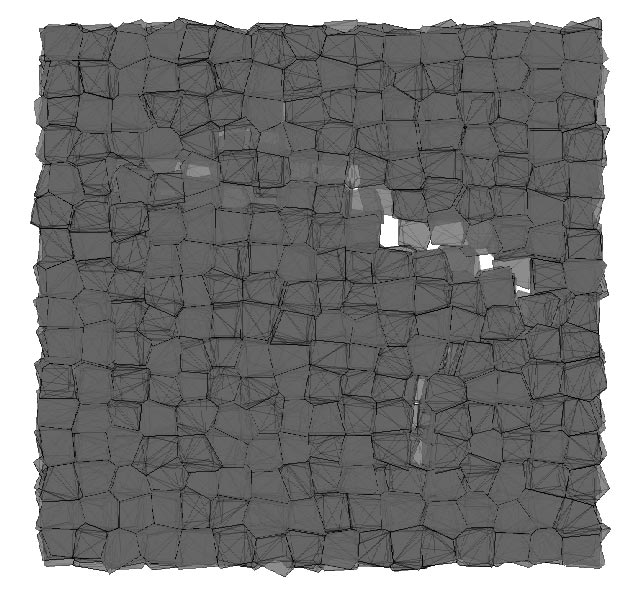 Fig. 3: The 3D simulation of shrinkage in a surface of a thin plate with a lattice model.
Fig. 3: The 3D simulation of shrinkage in a surface of a thin plate with a lattice model.
[1] J. Sima, M. Jiang, and C.Zhou (2014). Numerical simulation of desiccation cracking in a thin clay layer using 3D discrete element modeling. Computers and Geotechnics 56, 168–180.
[2] P. Grassl (2009). A lattice approach to model flow in cracked concrete.Cement & Concrete Composites 31 (2009) 454–460
[3] T. D. Vo, A. Pouya, S. Hemmati, A. M. Tang (2017). Numerical modelling of desiccation cracking of clayey soil using a cohesive fracture method. Computers and Geotechnics 85, 15–27
After detailed planning from BGR, IfG and CAU, a BGR team conducted the first drilling campaign in the underground research laboratory Mont Terri, Switzerland. 15 m cores of Opalinus Clay, sandy facies, have been gained by double core barrel. The cores have carefully been separated and put into liners, flooded with nitrogen, in order to prevent drying of the clay. They are now in the laboratories of IfG and CAU for laboratory testing. The drilling has been done in the framework of the Mont Terri Experiment “Experimental-Numerical Analysis of Discontinuities (AD)”.
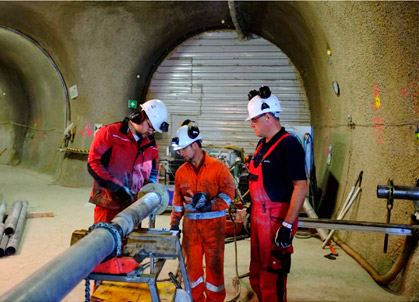 AD experiment: The BGR drilling team drilling borehole BAD-1. Photo: S. Schefer, swisstopo
AD experiment: The BGR drilling team drilling borehole BAD-1. Photo: S. Schefer, swisstopo
Concerning numerical investigations, the BGR and UFZ are working jointly on the development of methods for shrinkage and swelling of clayey materials in the framework of hydraulic-mechanically coupled processes. With a swelling stress, depending on water saturation, in-situ observed phenomena can be explained. In order to get a better fit to measurements, incorporation of non-linear mechanics, as Non-Local Damage (NLD) and Phase-Field (PF), will be tested.
Within WP1, the UFZ team improved existing elasto-plastic constitutive formulations for fault evolution in single-phase hydromechanical settings, and implemented cohesive zone models for fault propagation as well as specific hydraulic fracture flow laws into numerical methods in OpenGeoSys using enriched finite element spaces. These models are currently tested in preliminary simulations in the context of fault slip experiments in Opalinus clay in Mt. Terri. Preparations for extensions to multiphase settings are ongoing.
Regarding the laboratory investigations at the IfG and CAU, one main topic during past months was how to get claystone samples from Mt. Terri underground laboratory. At an WP1 meeting, which was held at the BGR in Hannover in December 2017, the framework of experimental an theoretical topics was discussed. This includes the number of samples, the type of claystone and the time schedule for drilling and transporting the core samples. BGR will propose an experiment at the Mt. Terri Technical Meeting (February 2018, Porrentruy, Switzerland), to build a bridge between the Mont Terri and the GeomInt project.
